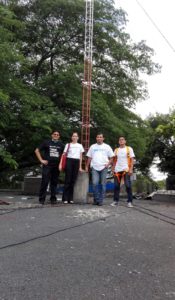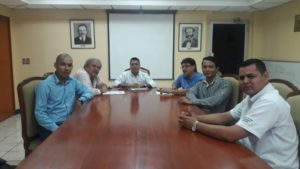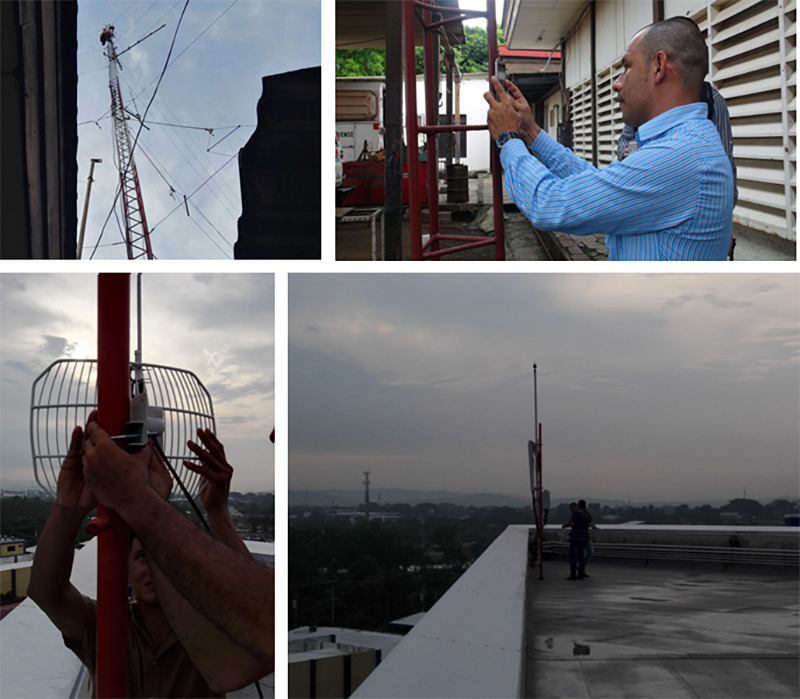
Fig 1. Team members of TIC Nicaragua SIGHT Group at one of the National University of Engineering communication points
The project “Hybrid Wireless Ad Hoc Network Implementation (Testbed) For Facing Seismic Catastrophes,” a project sponsored by IEEE SIGHT, supported by the IEEE Nicaragua Section, and under execution by the IEEE SIGHT “TIC Nicaragua SIGHT,” has successfully executed its initial steps, installing and setting up several radio links between strategic communications points of Managua. These radio-links are part of a Hybrid Wireless Ad Hoc Network Design to ensure communication means in order to grasp the information in a disaster area, contribute to resident’s safety and deliver goods on the occurrence of a disaster.
The radio links communication were implemented at Nicaraguan Red Cross (NRC) Headquarters, National University of Engineering (UNI) Headquarters, and further a communication point will be set up at El Crucero in order to enable communications among these three points and the ballooned wireless network nodes can be deployed wherever it is needed in emergencies. Fig. 1 depicts some of the team member at one of the National University of Engineering (UNI) Headquarters communication point under evaluation. All of the communications points are located in Managua, capital of Nicaragua, which is especially prone to seismic events.
This project purpose is oriented to contribute to the strengthening of the communication system of the organizations in charge of Disasters Management in Nicaragua using wireless ad hoc networks, specifically Nicaraguan Red Cross; Fig. 2 shows project member and NRC representatives at NRC’s headquarters in a work meeting.

Fig 2. Project members in a meeting with stakeholders of Nicaraguan Red Cross (NRC) at NRC Headquarter
Expected Results of the Project
As the main results of this project , the TIC Nicaragua SIGHT expects to implement a prototype hybrid wireless ad hoc network system including at least one (ballooned) wireless network node, two radio-links (i.e. two fixed nodes), a configured WLAN that will allow the connection of laptops, Smartphones, and wireless IP telephones (to send and receive text, voice, video). This hybrid network will function as a communication means to address emergencies for facing seismic catastrophes.
As previously mentioned, currently two radio-links were installed (Figs. 3, 4, 5 and 6 shows fieldwork installing and setting up the radio-links at NRC Headquarters and UNI).
The projects includes the following steps:
- The deployment of the ballooned c wireless network node, and the measurements of parameters of optimal height, coverage area, and latency of the transmitted data packets related to QoS.
- Training to one member of the Nicaraguan Red Cross’ technical staff in order to allow the self-deployment of the network.
- Horizontal Communication Test between Two Ballooned Mesh Points. A second ballooned mesh point will be deployed at the headquarters (UNI) to a distance of 400-800 mts. of the ballooned mesh point gateway. The goals of the test will be: (i) to ensure the communication and measure the distance between both ballooned mesh points at UNI preserving QoS (time delay of the communication); and (ii) also ensure the communication between ballooned mesh point (i.e. mesh point gateway) and the fixed mesh point at El Crucero.
- Evaluate performance of throughput, packet loss rate for both BWMSs and disaster applications.

[Clockwise top left] Fig 3. Technical assistant installing antenna at NRC Headquarters. Fig 4. Project member measuring geo-referenced coordinates at NRC Headquarters. Fig 5. Team member and volunteer installing antenna a UNI Headquarters. Fig 6. Team members of TIC Nicaragua SIGHT Group at one of the National University of Engineering communication points

